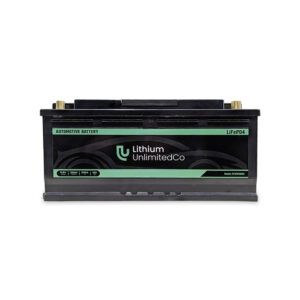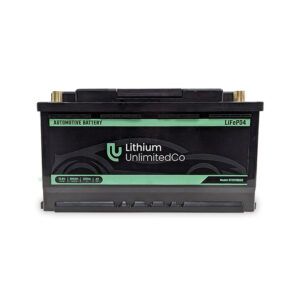NEWS & Blogs

Why Does Low Temperature Affect Li-Ion Batteries?
Posted by Lithium UnlimitedCo
Li-ion batteries have become an indispensable part of modern life, powering everything from smartphones and laptops to electric vehicles and renewable energy storage systems. However, despite their widespread use and convenience, these batteries are not immune to the effects of environmental factors, particularly temperature fluctuations. In this blog, we delve into the intricate relationship between low temperature and Li-ion batteries, unraveling the mechanisms behind their sensitivity to cold environments.
Exploring the Impact of Low Temperature on Li-ion Batteries
Understanding Li-ion Batteries
It is important to understand the basic science of Li-ion batteries in order to understand how they respond to low temperatures. The electrodes, electrolyte, and divider in these rechargeable batteries contribute to their production up.
When the battery is charged, ions move from the positive electrode (cathode) to the negative electrode (anode). When the battery is discharged, they move back the other way. Li-ion batteries store energy through this electrochemical process.
Effects of Low Temperature on Li-ion Batteries
Decreased Capacity
Low temperatures hinder the movement of ions within the battery, reducing its overall capacity to store energy. This phenomenon is attributed to the sluggish diffusion of lithium ions and electrons at colder temperatures.
As a result, the battery’s ability to hold a charge diminishes, leading to shorter operating times for devices and decreased driving range for electric vehicles.
This elevated internal resistance translates to reduced power output and efficiency, as the battery struggles to deliver current to the device or vehicle it powers.
Voltage Instability
Temperature variations can also induce voltage instability in Li-ion batteries. Cold temperatures alter the voltage characteristics of the battery, leading to fluctuations in output voltage during discharge. This instability poses risks, particularly in critical applications where consistent voltage supply is essential for device operation.
Formation of Solid Electrolyte Interface (SEI)
At low temperatures, a solid electrolyte interface (SEI) layer forms on the surface of the battery electrodes. While SEI formation is a natural process, it can be exacerbated in cold environments, affecting battery performance and longevity. The presence of a thick and resistive SEI layer impedes ion flow, further contributing to capacity loss and reduced efficiency.
Lithium Plating
Furthermore, extreme cold can lead to a phenomenon called lithium plating. Imagine tiny bumps forming on the highway, blocking the smooth flow of traffic. Similarly, extreme cold can cause lithium to form deposits on the anode, permanently reducing its capacity to store ions. In severe cases, this plating can even pose safety concerns.
Increased Internal Resistance
In cold conditions, the internal resistance of Li-ion batteries tends to rise due to sluggish ion movement and increased resistance within the electrolyte and electrodes.This elevated internal resistance translates to reduced power output and efficiency, as the battery struggles to deliver current to the device or vehicle it powers.
Voltage Instability
Temperature variations can also induce voltage instability in Li-ion batteries. Cold temperatures alter the voltage characteristics of the battery, leading to fluctuations in output voltage during discharge. This instability poses risks, particularly in critical applications where consistent voltage supply is essential for device operation.
Formation of Solid Electrolyte Interface (SEI)
At low temperatures, a solid electrolyte interface (SEI) layer forms on the surface of the battery electrodes. While SEI formation is a natural process, it can be exacerbated in cold environments, affecting battery performance and longevity. The presence of a thick and resistive SEI layer impedes ion flow, further contributing to capacity loss and reduced efficiency.
Lithium Plating
Furthermore, extreme cold can lead to a phenomenon called lithium plating. Imagine tiny bumps forming on the highway, blocking the smooth flow of traffic. Similarly, extreme cold can cause lithium to form deposits on the anode, permanently reducing its capacity to store ions. In severe cases, this plating can even pose safety concerns.

Practical Implications and Solutions
Performance Degradation in Cold Environments
The impact of low temperature on Li-ion battery performance is evident in various applications, such as electric vehicles experiencing reduced range in winter conditions and smartphones exhibiting shorter battery life in cold weather. To mitigate performance degradation, manufacturers and users alike must employ strategies tailored to cold environments.
Design Considerations
Battery designers are increasingly focusing on developing solutions to minimize the effects of temperature on Li-ion batteries. Specialized designs, such as thermal management systems and materials with enhanced conductivity, help maintain optimal operating conditions even in extreme temperatures.
Operational Guidelines
For users, adopting certain practices can help optimize Li-ion battery performance in cold weather. Storing devices in insulated cases, pre-warming batteries before use, and avoiding high discharge rates in chilly conditions are some recommended strategies to mitigate the impact of low temperature on battery life.
Future Perspectives
As research in battery technology continues to advance, promising developments are on the horizon to address temperature sensitivity in Li-ion batteries. From novel materials and chemistries to innovative thermal management solutions, the future holds exciting possibilities for enhancing the performance and reliability of batteries in cold environments.
Design Considerations
Battery designers are increasingly focusing on developing solutions to minimize the effects of temperature on Li-ion batteries. Specialized designs, such as thermal management systems and materials with enhanced conductivity, help maintain optimal operating conditions even in extreme temperatures.
Operational Guidelines
For users, adopting certain practices can help optimize Li-ion battery performance in cold weather. Storing devices in insulated cases, pre-warming batteries before use, and avoiding high discharge rates in chilly conditions are some recommended strategies to mitigate the impact of low temperature on battery life.
Future Perspectives
As research in battery technology continues to advance, promising developments are on the horizon to address temperature sensitivity in Li-ion batteries. From novel materials and chemistries to innovative thermal management solutions, the future holds exciting possibilities for enhancing the performance and reliability of batteries in cold environments.
Discover the Difference with Lithium Unlimited Co
At Lithium Unlimited Co, we’re passionate about powering your adventures with our cutting-edge marine and power sport batteries. Our lithium-ion battery technology is engineered to withstand the toughest conditions, including extreme temperatures, ensuring optimal performance when you need it most.
Whether you’re navigating the open waters or tearing up the trails, our batteries deliver unparalleled reliability, lightweight design, and long-lasting power. Say goodbye to the limitations of traditional batteries and embrace the freedom and flexibility that Lithium Unlimited Co batteries provide. Experience the next level of performance and efficiency for your marine and power sport needs with Lithium Unlimited Co.
Conclusion
In conclusion, the sensitivity of Li-ion batteries to low temperature is a critical consideration in their design, operation, and performance. By understanding the underlying mechanisms and implementing appropriate strategies, we can minimize the adverse effects of cold weather on battery life and ensure reliable power supply in diverse applications.
Conclusion
In conclusion, the sensitivity of Li-ion batteries to low temperature is a critical consideration in their design, operation, and performance. By understanding the underlying mechanisms and implementing appropriate strategies, we can minimize the adverse effects of cold weather on battery life and ensure reliable power supply in diverse applications.
Recent Posts
-
Why Choose LFP Over AGM for Safety? How and Why
-
Why Lithium Golf Cart Batteries are a Game Changer for Sports Enthusiasts
-
Cold Weather Challenges For Lithium Battery For Vehicles And How To Overcome Them
-
How to Keep Your Snowmobile Battery Running All Winter
-
Are Lithium Batteries Good in Cold Weather?

